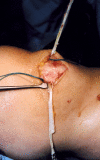Medial patellofemoral ligament reconstruction: a new technique
- PMID: 17328810
- PMCID: PMC1808455
- DOI: 10.1186/1471-2474-8-22
Medial patellofemoral ligament reconstruction: a new technique
Abstract
Background: Primary patellofemoral dislocations are common. In most patients, non-operative management produces satisfactory outcome. If the dislocation recurs after a trial of rehabilitation, operative intervention is considered, with the aim of restoring the soft tissue anatomy to normal. Ninety four percent of patients suffer a tear to the medial patellofemoral ligament (MPFL) following a patellar dislocation.
Results: We describe our transverse patella double tunnel technique to reconstruct the medial patellofemoral ligament using a free autologous gracilis or semitendinous graft.
Figures








Similar articles
-
Comparison of 2 different techniques for anatomic reconstruction of the medial patellofemoral ligament: a prospective randomized study.Am J Sports Med. 2013 May;41(5):1013-21. doi: 10.1177/0363546513480468. Epub 2013 Mar 22. Am J Sports Med. 2013. PMID: 23524153 Clinical Trial.
-
The Anatomy of the Medial Patellofemoral Ligament.Orthopedics. 2017 Jul 1;40(4):e583-e588. doi: 10.3928/01477447-20170223-03. Epub 2017 Feb 28. Orthopedics. 2017. PMID: 28241086 Review.
-
Lateral patellofemoral ligament reconstruction.Arthroscopy. 2004 Nov;20(9):998-1002. doi: 10.1016/j.arthro.2004.07.005. Arthroscopy. 2004. PMID: 15525935
-
Medial patellofemoral ligament reconstruction: indications and technique.Sports Med Arthrosc Rev. 2012 Sep;20(3):162-70. doi: 10.1097/JSA.0b013e318264188b. Sports Med Arthrosc Rev. 2012. PMID: 22878657 Review.
-
Medial patellofemoral ligament reconstruction fixed with a cylindrical bone plug and a grafted semitendinosus tendon at the original femoral site for recurrent patellar dislocation.Am J Sports Med. 2011 Jan;39(1):140-5. doi: 10.1177/0363546510377436. Epub 2010 Oct 7. Am J Sports Med. 2011. PMID: 20929934
Cited by
-
Modern management of patellar instability.Int Orthop. 2012 Dec;36(12):2447-56. doi: 10.1007/s00264-012-1669-4. Epub 2012 Oct 7. Int Orthop. 2012. PMID: 23052278 Free PMC article. Review.
-
Medial Patellofemoral Ligament Reconstruction: An Uncommon Solution for a Common Problem.Int J Appl Basic Med Res. 2022 Apr-Jun;12(2):144-147. doi: 10.4103/ijabmr.ijabmr_445_21. Epub 2022 May 10. Int J Appl Basic Med Res. 2022. PMID: 35754665 Free PMC article.
-
[Patella dislocation].Unfallchirurg. 2011 Apr;114(4):345-58; quiz 359. doi: 10.1007/s00113-011-2012-z. Unfallchirurg. 2011. PMID: 21465418 German.
-
A computed tomography cadaveric study of the radiological anatomy of the patella: the size of the patella correlates with bone bridge between tunnels and R angles are introduced for safe tunnel drilling during MPFL reconstruction.J Exp Orthop. 2021 Apr 17;8(1):29. doi: 10.1186/s40634-021-00348-9. J Exp Orthop. 2021. PMID: 33864169 Free PMC article.
-
I.S.Mu.L.T. first-time patellar dislocation guidelines.Muscles Ligaments Tendons J. 2017 May 10;7(1):1-10. doi: 10.11138/mltj/2017.7.1.001. eCollection 2017 Jan-Mar. Muscles Ligaments Tendons J. 2017. PMID: 28717605 Free PMC article.
References
MeSH terms
LinkOut - more resources
Full Text Sources

